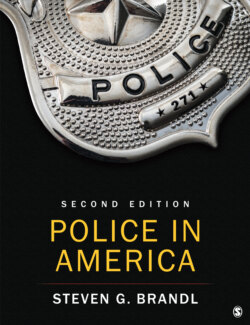Читать книгу Police in America - Steven G. Brandl - Страница 57
На сайте Литреса книга снята с продажи.
The Role of the Police During the Political Era
ОглавлениеThe capabilities of the police at the time were minimal, although officers were on duty twenty-four hours a day and police departments were better staffed than were the watches. In many cities, the first policemen wore designated hats and carried wooden clubs, but they did not wear uniforms. Not until the late 1800s did police officers begin to routinely carry firearms. In large cities, officers were assigned to extensive beats and they patrolled on foot. Some areas of cities were not patrolled at all. There was no system of communication between citizens and the police or between the police officers themselves. There were no means by which police supervisors could supervise their officers; as a result, there were very few supervisors. Needless to say, seldom were citizens able to find the police when they were needed. This situation created an environment where politicians could easy influence and control the officers’ activities and the police department in general. Cities were typically divided into wards; each ward had an elected ward leader, and the police in each ward were accountable to that leader. Many police activities were political, including campaigning and, at times, assisting in rigging elections.21 Indeed, corruption among politicians and their police forces was rampant. Payoffs and bribes were an unquestioned aspect of policing at the time. Officers accepted bribes not to enforce laws; officers paid bribes to get promoted. Chiefs and political leaders were in on the action as well, demanding a portion of the bribes accepted by officers.
Street-corner call boxes were put in place in the late 1800s. A call box was a metal box on a pole with what amounted to be a rudimentary telephone inside the box. Call boxes provided a means by which officers could communicate with supervisors at the police station, and they allowed supervisors to monitor the location of officers on the beat. However, call boxes were often vandalized by officers. They represented a first attempt to control and improve the police, if a rather unsuccessful one.
Beyond serving the interests of politicians, the police were primarily engaged in providing services to citizens: They ran soup lines, provided lodging to immigrant workers, and assisted in finding work for immigrants, all upon the direction of political leaders.22 Something that the police did not do very often was make arrests. More than half of all arrests made at this time were for public drunkenness.23 This was an offense that beat cops could easily discover with no investigation necessary. The police simply did not have the capability to respond to and investigate crimes. When an arrest was made, it was usually as a last resort. Making an arrest in the late 1800s presented some serious logistical difficulties; officers would literally have to “run ’em in” to the police station or, when arresting a drunk, use a wheelbarrow and wheel him into the station.24 So-called curbside justice with a wooden baton often became an alternate means of dealing with drunken citizens and other law breakers.
curbside justice: The use of force by police rather than arrest to deal with law breakers.
